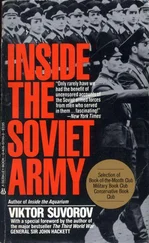Viktor Suvorov - Inside soviet military intelligence
Здесь есть возможность читать онлайн «Viktor Suvorov - Inside soviet military intelligence» весь текст электронной книги совершенно бесплатно (целиком полную версию без сокращений). В некоторых случаях можно слушать аудио, скачать через торрент в формате fb2 и присутствует краткое содержание. Год выпуска: 1984, ISBN: 1984, Жанр: Публицистика, Прочая документальная литература, на английском языке. Описание произведения, (предисловие) а так же отзывы посетителей доступны на портале библиотеки ЛибКат.
- Название:Inside soviet military intelligence
- Автор:
- Жанр:
- Год:1984
- ISBN:0-02-615510-9
- Рейтинг книги:3 / 5. Голосов: 1
-
Избранное:Добавить в избранное
- Отзывы:
-
Ваша оценка:
- 60
- 1
- 2
- 3
- 4
- 5
Inside soviet military intelligence: краткое содержание, описание и аннотация
Предлагаем к чтению аннотацию, описание, краткое содержание или предисловие (зависит от того, что написал сам автор книги «Inside soviet military intelligence»). Если вы не нашли необходимую информацию о книге — напишите в комментариях, мы постараемся отыскать её.
Inside soviet military intelligence — читать онлайн бесплатно полную книгу (весь текст) целиком
Ниже представлен текст книги, разбитый по страницам. Система сохранения места последней прочитанной страницы, позволяет с удобством читать онлайн бесплатно книгу «Inside soviet military intelligence», без необходимости каждый раз заново искать на чём Вы остановились. Поставьте закладку, и сможете в любой момент перейти на страницу, на которой закончили чтение.
Интервал:
Закладка:
Organisationally, the Soviet Army consists of sixteen military districts, four 'groups of forces' - in Germany, Poland, Hungary and Czechoslovakia - and four fleets - the Northern, Pacific, Black Sea and Baltic fleets. On the staff strengths of each district, group and fleet there are intelligence directorates. In all, these directorates number twenty-four. They are all subject to the GRU and are, in effect, a GRU in miniature. Each of these mini-GRU's utilises its own facilities. With all the forces at their disposal, they gather information on the enemy, both in peace-time and wartime.
When we speak of an intelligence directorate of a district, group or fleet as a mini-GRU, this does not in the least mean that the intelligence directorate is small or weak. We only mean that the intelligence directorates (RU) of staffs are smaller than the chief directorate of the general staff. But each of these twenty-four intelligence directorates is sufficiently strong to be able to recruit agents independently in the territories of countries or groups of countries which are in the sphere of interest of the given district, group or fleet. Each intelligence directorate possesses sufficient power to be able, without assistance, to disrupt life in any contiguous country or group of countries. There is only one form of intelligence possessed by the GRU which the intelligence directorates do not possess, and this is cosmic or space intelligence. At the same time, instead of this, they have a perhaps no less important means, which are the diversionary Spetsnaz units. In addition to ordinary agents providing secret information, the intelligence directorates recruit special agent-terrorists destined to murder statesmen or senior military officers and to carry out general terror in the country or group of countries. Thus each district, group of forces or fleet has its own two independent secret agent networks, the first being the ordinary espionage network, and the second the espionage-terrorist network called Spetsnaz. To visualize the strength of one intelligence directorate, it is sufficient to remember that each one controls an entire Spetsnaz brigade: 1,300 professional cut-throats continually in readiness to penetrate the territory of a contiguous state and go to the assistance of the agent-terrorists.
One can best imagine Soviet military intelligence in the form of a powerful, feudal state - the GRU - with a first-class army. There are twenty-four lesser satellite states, the intelligence directorates (RU), subordinated to the head of this state, and each of these in its turn has its own army, and a strong one at that. But each satellite also has its vassals each of whom has his own army and his own vassals, also with armies, and so forth. The only difference as regards this pyramid form of subordination is that Soviet military intelligence does not operate on the principle that 'the vassal of vassal is not my vassal'. The GRU fully and without delegating authority controls every step of the pyramid. These steps need to be examined.
Each military district and group of forces consists ot armies. Each fleet consists of flotillas which are equivalent to the armies of the land forces. On the staff of each army there is an intelligence department (RO) which is in effect a full vassal of the superior intelligence directorate and the still superior chief intelligence directorate. The intelligence department (RO) of an army or flotilla does run an agent network of its own. On the strength of each intelligence department, and there are in the Soviet armed forces at least fifty, there is a Spetsnaz company. This company, which numbers 115 saboteurs and cut-throats, is capable of penetrating into the enemy's territory to murder and kidnap people, blow up bridges, electric power stations, dams, oil pipelines and so on. And these Spetsnaz units are supplemented by the intelligence department's wide choice of electronic, air and other types of intelligence.
An army in the Soviet Union consists of from four to six divisions. In peace-time there are in the Soviet armed forces about 180 tank and motorised divisions. In the interests of simplification we can omit the eight divisions of airborne forces (VDV), the brigades of marine infantry belonging to the fleets and still many more branches of the Soviet Army which have intelligence units subordinated directly to the GRU of the general staff. On the strength of the staff of each division there is a chief reconnaissance officer. He has his own troops, a reconnaissance battalion, and his vassals, the heads of regimental reconnaissance and their troops. The reconnaissance battalion of each division, apart from tank and electronic reconnaissance, has a sabotage company which is also staffed with cut-throats capable of successful operations in the enemy's rear. In the interests of accuracy it is necessary to add that not all of the 180 tank and motorised rifle divisions have a full complement of personnel in peace-time; many of them have a complete technical staff and full officer strength, but only a partial complement of soldiers and NCOs. However, this rule does not apply to reconnaissance units. All the Spetsnaz brigades and companies of the military districts and armies, all the reconnaissance battalions (180) of the divisions, all the regimental reconnaissance companies (more than 700), are always kept at full strength and staffed by elite officers and NCOs.
Everything that we have listed comes under the indivisible control of the GRU, although none of it is called by this name. The researcher who studies the GRU but does not take into consideration the GRU's vassals will have overlooked twenty-four separate espionage organisations, each of which is as powerful as the intelligence service of one central European country. He will have overlooked 100,000 elite troops possessing as many fighting vehicles as a well-equipped Western European country. But even that is not all. In addition to its official vassals the GRU also has unofficial vassals who carry out the orders of the GRU as precisely and with as much jealous zeal as do the intelligence directorates of military districts, the intelligence departments of armies and the chief reconnaissance officers of divisions and regiments. These are the military intelligence services of Cuba, Poland, East Germany, Czechoslovakia, Hungary, Bulgaria, Mongolia and a number of other countries. These countries are satellites and in the full meaning of the word vassals of the Soviet Union. Their secret police forces are under the complete control of the Soviet KGB and take the form of a miniature copy of the KGB. Their armies are in thrall to the Soviet Army and their military intelligence services are full vassals of the GRU, with all their agents, illegals, military attaches, sabotage agents, diversionary troops and so on. But of these later.
Chapter Four
The GRU and the Military Industrial Commission (VPK)
When we use the term 'army' with regard to the Soviet Army we must have in mind not only the Ministry of Defence, but also the twelve other ministries whose sole function it is to produce weapons and military technology. Together all these ministries form the high-powered monolith headed by the military industrial commission (VPK). Included in the collegium of the military industrial commission are: one of the first deputies of the chairman of the council of ministers, thirteen ministers, and the chief of the general staff and the chief of the GRU. The military industrial commission is the Army and the Army is the military industrial commission. When we talk of a struggle between the Army and the Party and the KGB we have in mind the struggle of the whole military industrial commission, whose fortunes wax and wane in perfect harmony with the Army's own.
The economic and financial might of the military industrial commission can only be compared with the might of the Soviet Union itself. Theoretically the Soviet Union spends, in the interests of defence, the improbably small sum of nineteen billion roubles a year. This nineteen billion, however, is the budget of the Ministry of Defence alone. The budgets of the remaining twelve ministries which produce armaments are kept secret. The Soviet system is constructed in such a way that the Ministry of Defence does not buy; it receives the armaments necessary to it. For example, an aircraft carrier is under construction in the Soviet Union. The Ministry of Defence does not bear any of the cost of this. The price of the ship is paid to the Ministry of Shipbuilding by the Council of Ministers under the debit item shipbuilding industry'. This Ministry, by the way, has never constructed any non-military vessels. Non-military vessels are, without exception, bought for the Soviet Union in Poland, East Germany, Yugoslavia, Bulgaria, Italy, France, Norway, Sweden, Denmark - it is difficult indeed to list all of them. It is probably true that only Switzerland is an exception to this list. The same thing is true of aircraft, tanks, rockets, nuclear bombs, military electronics, every item of hardware. Nobody in the Soviet Union knows exactly how much the military industrial commission swallows up, but in any case it is an astronomical figure.
Читать дальшеИнтервал:
Закладка:
Похожие книги на «Inside soviet military intelligence»
Представляем Вашему вниманию похожие книги на «Inside soviet military intelligence» списком для выбора. Мы отобрали схожую по названию и смыслу литературу в надежде предоставить читателям больше вариантов отыскать новые, интересные, ещё непрочитанные произведения.
Обсуждение, отзывы о книге «Inside soviet military intelligence» и просто собственные мнения читателей. Оставьте ваши комментарии, напишите, что Вы думаете о произведении, его смысле или главных героях. Укажите что конкретно понравилось, а что нет, и почему Вы так считаете.












